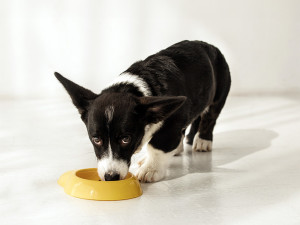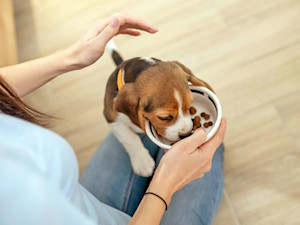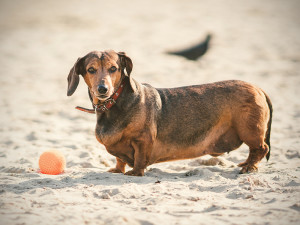How Much Should I Feed My Dog Based on Their Weight?
Learn how to feed your dog just right – no more, no less

Share Article
We’ve all been there – caught in the crosshairs of those puppy eyes, begging for just one more bite of your snack. But how do you know if your dog genuinely needs more food or is just pulling off an Oscar-worthy performance?
Before you surrender to the infamous ‘cheese tax’, let’s explore the ins and outs of canine nutrition to find out how much you should actually feed your dog to ensure your four-legged friend is getting everything they need – and nothing they don’t.
How do I determine how much to feed my dog based on their weight?
Dog nutrition might sound like rocket science with its ever-changing evidence, but it doesn’t have to be. At its core, a balanced dietopens in new tab provides energy through carbohydrates, proteins and fats. Following the principles of moderation, variety and balanceopens in new tab ensures your dog gets the right calories, vitamins and nutrients.
Moderation to get the right amount of calories needed for energy through the day, variety in order to get the vitamins and minerals that are found in some ingredients, but not others, and balance which means getting the right amount of these components. One way to find out the calorie needs of your dog is by using a nutrition calculator.
Since every dog is unique in size, energy needs and the type of food they eat, there’s no one-size-fits-all answer. So how do we know how much to feed our dogs? Your best starting point? Check the feeding guidelines on the back of your dog food packaging. These charts often list portion sizes by weight, but remember – these are just guidelines. Adjust portions based on whether your dog eats once or twice a day.
What impacts how much to feed a dog?
Every dog is unique, and their dietary needs can vary widely. If you’re ever unsure about the right amount or type of food for your pet, consult your vet for personalised advice.
Age
Puppies are tiny powerhouses of energy and growthopens in new tab. They need a diet high in proteinopens in new tab (at least 25 percent) and fats to fuel their development.
Interestingly, small breed puppies require more calories per pound of body weight than large breeds. This might seem counter intuitive, but larger breed pups have a slower growth process in order to allow time to develop, so they actually need a specific diet with fewer calories per gram, and sometimes lower in calcium and phosphorous than their smaller four-legged friends. Always pick the puppy food that relates to your own pup’s build to ensure healthy growth.
Physical activity
Is your dog an athlete? Whether herding sheep, competing in agility or being your running coach, active dogs burn more calories and need diets with higher energy content. Dogs spending more energy in physical activities need it replaced in their meals, this means they need a diet with higher calories per unit of feed. Look for ‘working dog’ food to keep your pup in peak condition.
Breed
Different breeds, different needs! There are many new foods on the market targeting specific breeds, these tend to have more of the ingredients that help with specific breed related risks such as joint, heart or skin-related issues.
Larger breeds often benefit from foods tailored to joint and heart health, while smaller breeds might require nutrient-dense options to match their faster metabolism.
Being spayed or neutered
Neutering causes a lot of changes in a dog’s physiology, and the changes in hormones can cause an imbalance between energy consumption vs expenditureopens in new tab. Keep an eye on their weight post-surgery and adjust their food portions to maintain a healthy BCS (4–5 out of nine is ideal).
Health status
Illness and disease can take their toll on the body, this is why dogs with underlying health conditions will require a higher energy diet, along with any beneficial components that support the system most in need. For example, dogs with kidney issues thrive on renal-specific diets low in sodium and phosphorus. Always transition to new foods slowly to prevent tummy troubles like diarrhoea or vomiting.
What is a Body Condition Score (BCS)?
The body condition scoreopens in new tab is a pet version of the BMI (Body Mass Index) yardstick for humans. It is simple way to assess whether your dog is underweight, overweight or just right. It uses a scale, usually from 1–9, where:
1–3 means your dog is underweight: backbone and ribs visible with a severe waistline and tummy tuck.
4–5 is the ideal range, meaning your dog is healthy and lean: slight fat layer over ribs, backbone and pelvis. Tummy tuck and waistline present but minimal.
6–9 indicates your dog is overweight: ribs and backbone not palpable under thick fat layer. Abdomen sticks out downward (opposite of tummy tuck) and outward (protruding waistline).
To check your dog’s BCS, feel around their ribs and spine. You should be able to feel them without pressing too hard, but they shouldn’t be sticking out. Looking from above, your dog should have a visible waist, and from the side, a slight tummy tuck. If you’re unsure how to assess this, your vet can guide you.
How often should I feed my dog?
Historically, dogs evolved beside humans, relying on scavenging and leftovers to survive. Today, most dogs thrive on one or two structured meals per day. Some prefer smaller, more frequent meals, but be cautious – free-feeding can lead to overeating and weight gain in less active dogs, so adapt your routine to best suit your own pet.
Trial and error are part of the process. If your dog seems hungry between meals or gains weight, tweak their schedule and portions.
Feeding your dog: frequently asked questions
How much food should I feed my dog per kg a day?
Check the back of the dog food packaging for specific details for each type of food. In the UK, labelling requires dog food to supply a recommended feeding amount based on a dog’s weight in kg. These guidelines are a great starting point but may need fine-tuning depending on your dog’s activity level and metabolism.
How many times should I feed my dog a day?
Divide the daily portion into 1–2 meals for adults and 3–4 meals for puppies. Adjust based on your dog’s age and preferences.
How do I know my dog is getting the right amount of food?
Keep an eye on their body condition score and overall energy levels. Your dog should be lean but not bony, energetic but not hyperactive. If in doubt, consult your vet for a tailored feeding plan.
References
Delaney, Sean J., and Andrea J. Fascetti. Basic Nutrition Overviewopens in new tab. Aug. 2023, pp. 8–28. Accessed 23 Dec. 2024.
Nestle, Marion, and Malden Nesheim. Feed your pet right: the authoritative guide to feeding your dog and cat. Simon and Schuster, 2010.
UK Pet Food. “Puppy Nutritionopens in new tab.” Ukpetfood.org, 2024,. Accessed 23 Dec. 2024.
FEDIAF (2021) ‘Nutritional guidelines for complete and complementary pet food for cats and dogsopens in new tab’.
Phungviwatnikul, Thunyaporn, et al. “Effects of Diet on Body Weight, Body Composition, Metabolic Status, and Physical Activity Levels of Adult Female Dogs after Spay Surgeryopens in new tab.” Journal of Animal Science, vol. 98, no. 3, Oxford University Press (OUP), Mar. 2020. Accessed 23 Dec. 2024.
“Association for Pet Obesity Prevention.opens in new tab” Association for Pet Obesity Prevention , 5 Sept. 2024, www.petobesityprevention.org/pet-weight-check. Accessed 23 Dec. 2024.
Bąkowski, Maciej, et al. “Optimization of dogs’ nutrition-an overview of current research.opens in new tab” Journal of Elementology 29.2 (2024): 517-534.
Williams, K., & Buzhardt, L. “Body Condition Scoresopens in new tab”, Body condition scores: VCA Animal Hospitals. VCA. Accessed 14 Jan. 2025

Dr Josephine Corrick, BVMSci, BSc, MRCVS
Dr Josephine Corrick, BVMSci, BSc, MRCVS is a veterinary surgeon based in the south of Scotland where she has been since graduating from the University of Surrey. She enjoys working in general practice treating small animals. Her particular interests include diagnostic imaging and the treatment of wildlife.
Having found a passion for veterinary medicine after doing a degree in Equine Sports Science she still enjoys including horses in her life by spending time with her highland ponies. Alongside her clinical work, she helps run a smallholding caring for rare breed sheep and exploring the Scottish countryside with her young Cocker Spaniel.
Related articles
Can Puppies Eat Adult Dog Food?
They might want to hurry up and be a big kid, but here’s why it’s good to wait
![An obese dachshund dog plays with a rubber ball on a sandy beach]()
What to Know When Your Vet Says Your Dog is Overweight
Don’t take it personally – even if that’s hard to do
![A woman smiling at her dog while carrying a bowl of food.]()
Is Yoghurt Good For Your Dog?
It’s safe and healthy, and most dogs love it
![Young couple feeding their dog with healthy green food from the farmers market at home]()
8 Seasonal Fruits and Vegetables You Can Share With Your Dog
Eight in-season and vet-recommended fruits and veggies that make for healthy, sustainable snacks for your pet







